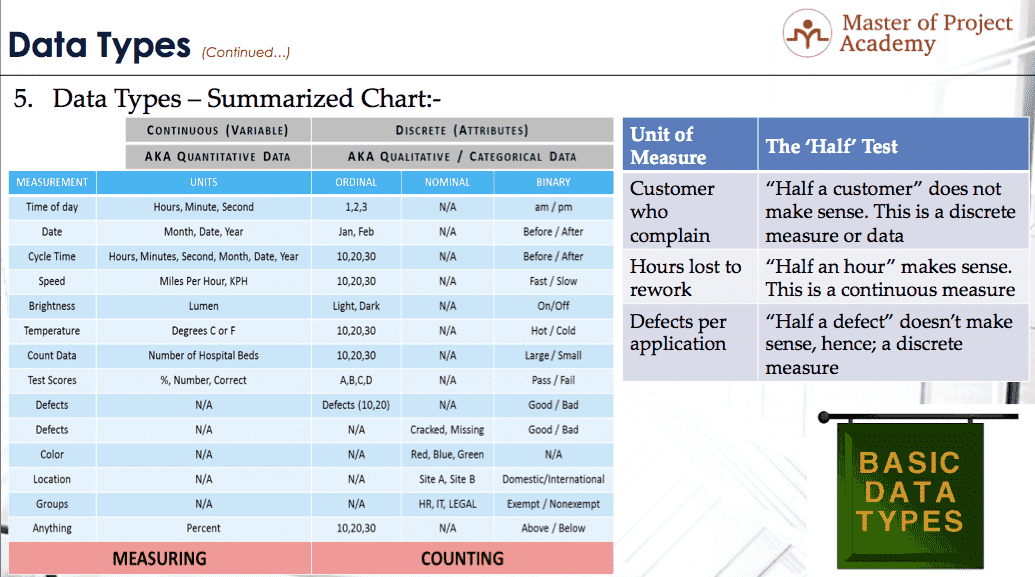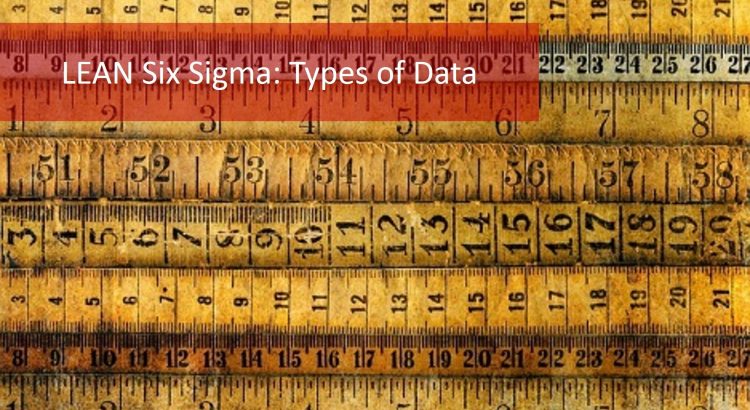The Six Sigma approach is a data-driven approach to problem-solving. It stands to reason that the people who study in a Lean Six Sigma Green Belt course will be confronted with different data types in Six Sigma measure phase. Even some reputable free Six Sigma Green Belt Certification training will cover different types of data when discussing the Six Sigma Measure phase of the DMAIC process. Understanding the different data types of Six Sigma measure phase is critical to the successful execution of the Six Sigma Measure phase as it affects how data will be measured, collected, analyzed and interpreted.
Understanding different data types of Six Sigma Measure Phase
Before we move towards the concept of types of data of Six Sigma measure phase, let’s first look at what “data” means. Data refers to organized or unorganized information. It can be numbers, words, measurements, observations or even just descriptions of things.
Attend our 100% Online & Self-Paced Free Six Sigma Training.
Types of data affect the execution of Six Sigma Measure phase
In the Six Sigma measure phase of the DMAIC process, before doing actual data collection, the project team should consider some statistical techniques including types of data and sampling. This is because these statistical techniques and the types of data that will be collected will affect how the team goes about collecting the data. The “X” or “Y” data in Six Sigma methodology can be either continuous data or discrete data. In other words, continuous and discrete are two different data types often used in Six Sigma measure phase.
Understanding the difference between continuous and discrete data is important because the difference influences how Six Sigma project teams define their measures, how they collect their data, and what they can learn from it. The difference also affects the sampling of data and how they will analyze it too. So we may say that it affects the whole Six Sigma measure phase.
Check our Six Sigma Training Video
The 1st Data Type of Six Sigma Measure Phase: Discrete Data
Discrete numeric data of Six Sigma Measure Phase
Let’s take a closer look at what discrete data means for Six Sigma measure phase. Discrete data is also known as attribute data. Discrete numeric data is countable in the sense that you can count how many of something there are. You can count items with a specific characteristic, or you can count the number of occurrences of an event or incident (Count Data). Discrete numeric data is measured by the presence or absence of a particular characteristic of each device that is being tested during Six Sigma measure phase.
Examples of discrete numeric data for Six Sigma measure phase would be:
- Number of people who pass a test
- Count of errors or number of errors on a bill
- Software errors in a software program
- Number of defects in a sample
- Number of days in a week
- Number of dimples on a golf ball
- Number of people in a stadium or arena
- Number of parts damaged in shipment
- Number of hours in a day

Discrete attribute data of Six Sigma Measure Phase
Let us now study what discrete attribute data means for Six Sigma measure phase. Discrete attribute data is qualitative in nature. Think of attributes as a way of categorizing or bucketing things. Let take a simple example. Animals could be a Cat, Dog, Rabbit or a Gerbil. A product ordered could be a CD, MP3 file or DVD. Not only can you count how many items have a certain attribute but you can also count how many items do not have a certain attribute. This can also be converted into a percentage. Now, let us study the 3 types of Discrete Attribute Data of Six Sigma measure phase.
Discrete ordinal data
The first type is discrete ordinal data. A set of data is said to be ordinal if the values/observations belonging to it can be ranked or put in order or have a rating scale attached. Note that ordinal data can be counted and set in order but it cannot be measured. For example, “The third tallest person in the class” (We don’t know how tall, only that there are two others taller than this person).
Let’s have a look at another example. Suppose a group of people was asked to taste varieties of biscuits and classify each biscuit on a rating scale of 1 to 5. The rating scale of 1 represents “Strongly Dislike,” the scale of 2 represents “Dislike,” The scale of 3 represents “Neutral,” the scale of 4 represents “Like, ” and the rating of 5 represents “Strongly Like.” In this case, a rating of 5 indicates more liking or enjoyment than the rating of 4. Such data are ordinal.
Discrete nominal data
The second type is discrete nominal Data. This type of data is descriptive, and not numeric, with more than two categories, for example; names, phone numbers, colors, type of car, capital cities and states. In a more general form, the data, assigned with labels or names, are considered as the data in nominal scale. Since each label or name indicates a separate category of the data, this data is also called ‘Categorical Data.’
Nominal data can also be equated to discrete values, for example, to distinguish among people such as sales representatives, marketing representatives, etc. However, to maintain some anonymity, they could be coded and referred to a discrete number whereby Sally = 1, John = 2, Michael = 3, and Ricky = 4. Moreover, the data, related to gender, race, religious affiliation, political affiliation, etc., are also nominal data.
Discrete binary data
The third type is discrete binary data. It is a qualitative or categorical type of data made up of two classifications. For example, Yes/No, Pass/Fail, On/Off, Male/Female, Good/Bad, Agree/Disagree, etc.
The 2nd Data Type of Six Sigma Measure Phase: Continuous Data
Continuous data of Six Sigma measure phase is also known as variable data. Common continuous measures are time, money and any physical measurement such as weight, height, length or temperature. Continuous Data can take on any value on a continuous scale such as temperature, distance, cycle time, profit. This is a type of data that is usually associated with some sort of physical measurement. Continuous data or measures are only those things that can be measured on an infinitely divisible continuum or scale.
The examples for continıus data of Six Sigma measure phase are as follows:
- Time (Hours, Minutes and Seconds)
- Height (Feet, Inches, Fractions of an inch and so on)
- Sound Level (Decibels)
- Temperature (Degrees Celcius and Fahrenheit)
- Electrical resistance (Ohms)
- Money (Dollars, Yens, Euros, and fractions thereof)
How to Distinguish The Different Data Types of Six Sigma Measure Phase?
Have a look at the figure below. This chart on data types of Six Sigma measure phase is a kind of summarized chart on discrete and continuous types of data. Please remember a fundamental rule about types of data here. Discrete data is all about counting while continuous data is all about measurements.

Let’s see how we are supposed to read this table. Look at the first column titled ‘Measurement.’ In the first row, the objective is to measure the time of the day. The units of measurement are hours, minutes and seconds. It is a piece of continuous data. Moving on in the same row, ordinal data for measuring the time of the day has been noted as 1, 2, and 3 without indicating any order among them. We can count 1, 2, 3 as 1 hour, 2 hours, 3 hours, etc. It is a piece of discrete ordinal data. Nominal data is not applicable to be measured against the time of the day. In the case of binary data, the time of the day can be measured as am/pm only. The time during the day can be expressed either as am or pm. It’s simply a close-ended answer.
A quick and easy way to distinguish data types of Six Sigma Measure Phase
Now, to understand the crux of data types of Six Sigma measure phase here is a quick test for distinguishing between discrete and continuous measures. Please have a look at the next table in the figure above. Think about the “Unit of Measure,” or the thing being measured and then ask yourself if “half of that thing” makes sense. If the answer is yes, then the measure is “Continuous.” If the answer is No, then we have a “Discrete” measure.
Knowledge of different data types of Six Simga measure phase is essential for the Six Sigma practitioner. The data types that he or she will be confronted with during the Six Sigma measure phase of a project will affect how the data is collected, analyzed and interpreted. Before you can collect data, you must first understand types of data and how it applied to your project during Six Sigma measure phase. Now that you know how to distinguish between the different types of data, you are ready to collect data for your project in Six Sigma measure phase.



2 thoughts on “2 Types of Data for Six Sigma Measure Phase”
Comments are closed.